The Behavioural Responses of Beef Cattle (Bos taurus) to Declining Pasture Availability and the Use of GNSS Technology to Determine Grazing Preference
Abstract
:1. Introduction
1.1. Pasture Monitoring
1.2. Livestock Behaviour and Tracking
1.3. Production Implications
2. Materials and Methods
2.1. Location and Animals
2.2. Pasture Biomass Measurement and Analyses
2.3. Behaviour Observations and Analyses
2.4. GNSS Collar Deployment and Analyses
2.5. Statistical Analyses
3. Results
3.1. Cattle Behaviour, Production and Pasture Availability
3.2. GNSS Collar Analysis
3.2.1. NDVI Preference
3.2.2. Distance Travelled
4. Discussion
4.1. Cattle Behaviour
4.2. Factors Influencing Grazing Behaviour
4.3. GNSS Collar Analysis
4.3.1. NDVI Preference
4.3.2. Distance Travelled
4.4. Limitations
5. Conclusions
Acknowledgments
Author Contributions
Conflicts of Interest
References
- Morris, J.E.; Cronin, G.M.; Bush, R.D. Improving sheep production and welfare in extensive systems through precision sheep management. Anim. Prod. Sci. 2012, 52, 665–670. [Google Scholar] [CrossRef]
- Pullanagari, R.R.; Yule, I.; King, W.; Dalley, D.; Dynes, R. The use of optical sensors to estimate pasture quality. Int. J. Smart Sens. Intell. Syst. 2011, 4, 125–137. [Google Scholar]
- Meisser, M.; Deléglise, C.; Freléchoux, F.; Chassot, A.; Jeangros, B.; Mosimann, E. Foraging behaviour and occupation pattern of beef cows on a heterogeneous pasture in the swiss alps. Czech. J. Anim. Sci. 2014, 59, 84–95. [Google Scholar]
- Trotter, T.F.; Frazier, P.; Trotter, M.G.; Lamb, D.W. Objective biomass assessment using an active plant sensor (crop circle), preliminary experiences on a variety of agricultural landscapes. In Proceedings of the Ninth International Conference on Precision Agriculture, Denver, CO, USA, 20–23 July 2008. [Google Scholar]
- Handcock, R.N.; Swain, D.L.; Bishop-Hurley, G.J.; Patison, K.P.; Wark, T.; Valencia, P.; Corke, P.; O’Neill, C.J. Monitoring animal behaviour and environmental interactions using wireless sensor networks, GPS collars and satellite remote sensing. Sensors 2009, 9, 3586–3603. [Google Scholar] [CrossRef] [PubMed]
- Edirisinghe, A.; Hill, M.J.; Donald, G.E.; Hyder, M. Quantitative mapping of pasture biomass using satellite imagery. Int. J. Remote. Sens. 2011, 32, 2699–2724. [Google Scholar] [CrossRef]
- Mitchell, A.R.; Pinter, P.J.; Guerrero, J.N.; Hernandez, C.B.; Marble, V.L. Spectral reflectance measurements of alfalfa under sheep grazing. Agron. J. 1990, 82, 1098–1103. [Google Scholar] [CrossRef]
- Tomkiewicz, S.M.; Fuller, M.R.; Kie, J.G.; Bates, K.K. Global positioning system and associated technologies in animal behaviour and ecological research. Philos. Trans. R. Soc. B 2010, 365, 2163–2176. [Google Scholar] [CrossRef] [PubMed]
- Rutter, S.M. The integration of GPS, vegetation mapping and GIS in ecological and behavioural studies. Rev. Bras. Zootecn. 2007, 36, 63–70. [Google Scholar] [CrossRef]
- Swain, D.L.; Friend, M.A.; Bishop-Hurley, G.J.; Handcock, R.N.; Wark, T. Tracking livestock using global positioning systems are we still lost? Anim. Prod. Sci. 2011, 51, 167–175. [Google Scholar] [CrossRef]
- Roberts, J.; Trotter, M.G.; Lamb, D.W.; Hinch, G.; Schneider, D.A. Spatio-temporal movement of livestock in relation to decreasing pasture biomass. In Food Security from Sustainable Agriculture, Proceedings of 15th Agronomy Conference Lincoln, Canterbury, New Zealand, 15–18 November 2010; Dove, H., Culvenor, R.A., Eds.; Australian Society of Agronomy: Lincoln, New Zealand.
- Rouse, J.; Haas, R.; Schell, J.; Deering, D. Monitoring Vegetation Systems in the Great Plains with ERTS. Proceedings from the Third ERTS Symposium, Washington, DC, USA, 10–14 December 1974; Freden, S.C., Mercanti, E.P., Eds.; U.S. Govt. Printing Office: Washington DC, USA, 1974; Volume 351, p. 309. [Google Scholar]
- Minasny, B.; McBratney, A.; Whelan, B. Vesper Version 1.62. Australian Centre for Precision Agriculture: McMillan Building A05, The University of Sydney, NSW 2006. 2005. Available online: http://www.usyd.edu.au/su/agric/acpa (accessed on 20 January 2017).
- ESRI. Arcgis Desktop 10.2; Environmental Systems Research Institute: Redlands, CA, USA, 2013. [Google Scholar]
- Lehner, P.N. Handbook of Ethological Methods, 2nd ed.; Cambridge University Press: Cambridge, UK, 1998. [Google Scholar]
- Manning, J.K.; Cronin, G.M.; González, L.A.; Hall, E.J.S.; Merchant, A.; Ingram, L.J. The effects of global navigation satellite system (GNSS) collars on cattle (Bos taurus) behaviour. Appl. Anim. Behav. Sci. 2017, 187, 54–59. [Google Scholar] [CrossRef]
- Trotter, M.G.; Lamb, D.W.; Hinch, G.N.; Guppy, C.N. Global navigation satellite system livestock tracking: System development and data interpretation. Anim. Prod. Sci. 2010, 50, 616–623. [Google Scholar] [CrossRef]
- Heglund, N.C.; Taylor, C.R. Speed, stride frequency and energy cost per stride: How do they change with body size and gait? J. Exp. Biol. 1988, 138, 301–318. [Google Scholar] [PubMed]
- Jacobs, J. Quantitative measurement of food selection. Oecologia 1974, 14, 413–417. [Google Scholar] [CrossRef] [PubMed]
- Butler, D. Asreml: Asreml Fits the Linear Mixed Model. R Package Version 3.2.0. Available online: http://www.vsni.co.uk (accessed on 10 February 2017).
- R Core Team. R: A Language and Environment for Statistical Computing; R Foundation for Statistical Computing: Vienna, Austria, 2015. [Google Scholar]
- Kilgour, R.J. In pursuit of “normal”: A review of the behaviour of cattle at pasture. Appl. Anim. Behav. Sci. 2012, 138, 1–11. [Google Scholar] [CrossRef]
- Chapman, D.F.; Parsons, A.J.; Cosgrove, G.P.; Barker, D.J.; Marotti, D.M.; Venning, K.J.; Rutter, S.M.; Hill, J.; Thompson, A.N. Impacts of spatial patterns in pasture on animal grazing behavior, intake, and performance. Crop Sci. 2007, 47, 399–415. [Google Scholar] [CrossRef]
- Launchbaugh, K.L.; Howery, L.D. Understanding landscape use patterns of livestock as a consequence of foraging behavior. Rangel. Ecol. Manag. 2005, 58, 99–108. [Google Scholar] [CrossRef]
- Arnold, G. The effect of the quantity and quality of pasture available to sheep on their grazing behaviour. Crop Pasture Sci. 1960, 11, 1034–1043. [Google Scholar] [CrossRef]
- Scarnecchia, D.L.; Nastis, A.S.; Malechek, J.C. Effects of forage availability on grazing behavior of heifers. J. Range Manag. 1985, 38, 177–180. [Google Scholar] [CrossRef]
- Senft, R.L.; Rittenhouse, L.R.; Woodmansee, R.G. Factors influencing patterns of cattle grazing behavior on shortgrass steppe. J. Range Manag. 1985, 38, 82–87. [Google Scholar] [CrossRef]
- Hancock, J. Studies of grazing behaviour in relation to grassland management I. Variations in grazing habits of dairy cattle. J. Agric. Sci. 1954, 44, 420–433. [Google Scholar] [CrossRef]
- Larson-Praplan, S.; George, M.R.; Buckhouse, J.C.; Laca, E.A. Spatial and temporal domains of scale of grazing cattle. Anim. Prod. Sci. 2015, 55, 284–297. [Google Scholar] [CrossRef]
- Roberts, J. Potential for Remote Monitoring of Cattle Movement to Indicate Available Biomass. Ph.D. Thesis, University of New England, Armidale, NSW, Australia, September 2014. [Google Scholar]
- Putfarken, D.; Dengler, J.; Lehmann, S.; Härdtle, W. Site use of grazing cattle and sheep in a large-scale pasture landscape: A GPS/GIS assessment. Appl. Anim. Behav. Sci. 2008, 111, 54–67. [Google Scholar] [CrossRef]
- O’Reagain, P.; Schwartz, J. Dietary selection and foraging strategies of animals on rangeland. Coping with spatial and temporal variability. In Recent Developments in the Nutrition of Herbivores, Proceedings of the IVth International Symposium on the Nutrition of Herbivores, Clermont–Ferrand, ARA, France, 11–15 September 1995; Journet, M., Grenet, E., Farce, M.-H, Theriez, M., Demarquilly, C., Eds.; INRA Editions: Paris, France, 1995; pp. 407–423. [Google Scholar]
- Coppock, D.L.; Ellis, J.E.; Detling, J.K.; Dyer, M.I. Plant-herbivore interactions in a North American mixed-grass prairie. II. Responses of bison to modification of vegetation by prairie dogs. Oecologia 1983, 56, 10–15. [Google Scholar] [CrossRef] [PubMed]
- Beever, D.E.; Offer, N.; Gill, M. The feeding value of grass and grass products. In Grass: Its Production and Utilisation, 3rd ed.; Hopkins, A., Ed.; Blackwell Scientific: Oxford, UK, 1989; pp. 140–195. [Google Scholar]
- Rutter, S.M. Diet preference for grass and legumes in free-ranging domestic sheep and cattle: Current theory and future application. Appl. Anim. Behav. Sci. 2006, 97, 17–35. [Google Scholar] [CrossRef]
- McLeod, M.; Smith, B. Eating and ruminating behaviour in cattle given forages differing in fibre content. Anim. Prod. 1989, 48, 503–511. [Google Scholar] [CrossRef]
- Mertens, D.; Ely, L. A dynamic model of fiber digestion and passage in the ruminant for evaluating forage quality. J. Anim. Sci. 1979, 49, 1085–1095. [Google Scholar] [CrossRef]
- Stejskalová, M.; Hejcmanová, P.; Pavlů, V.; Hejcman, M. Grazing behavior and performance of beef cattle as a function of sward structure and herbage quality under rotational and continuous stocking on species-rich upland pasture. Anim. Sci. 2013, 84, 622–629. [Google Scholar] [CrossRef] [PubMed]
- Arnold, G.W.; Dudzinski, M.L. Ethology of Free-Ranging Domestic Animals; Elsevier Scientific Pub. Co.: Amsterdam, The Netherlands, 1978; Volume 2. [Google Scholar]
- Howery, L.D.; Provenza, F.D.; Banner, R.E.; Scott, C.B. Differences in home range and habitat use among individuals in a cattle herd. Appl. Anim. Behav. Sci. 1996, 49, 305–320. [Google Scholar] [CrossRef]
- Boland, H.; Scaglia, G.; Fontenot, J.; Abaye, A.; Stewart, R.; Smith, S. Grazing behavior of beef steers consuming different tall fescue types and lakota prairie grass. Prof. Anim. Sci. 2007, 23, 721–727. [Google Scholar] [CrossRef]
- Hughes, G.P.; Reid, D. Studies on the behaviour of cattle and sheep in relation to the utilization of grass. J. Agric. Sci. 1951, 41, 350–366. [Google Scholar] [CrossRef]
- Sneva, F. Behavior of yearling cattle on eastern Oregon range. J. Range Manag. 1970, 23, 155–158. [Google Scholar] [CrossRef]
- Ganskopp, D.C.; Bohnert, D.W. Landscape nutritional patterns and cattle distribution in rangeland pastures. Appl. Anim. Behav. Sci. 2009, 116, 110–119. [Google Scholar] [CrossRef]
- Bailey, D.W.; Gross, J.E.; Laca, E.A.; Rittenhouse, L.R.; Coughenour, M.B.; Swift, D.M.; Sims, P.L. Mechanisms that result in large herbivore grazing distribution patterns. J. Range Manag. 1996, 49, 386–400. [Google Scholar] [CrossRef]
- George, M.; Bailey, D.; Borman, M.; Ganskopp, D.; Surber, G.; Harris, N. Factors and Practices that Influence Livestock Distribution. Available online: https://www.ars.usda.gov/research/publications/publication/?seqNo115=213526 (accessed on 18 May 2017).
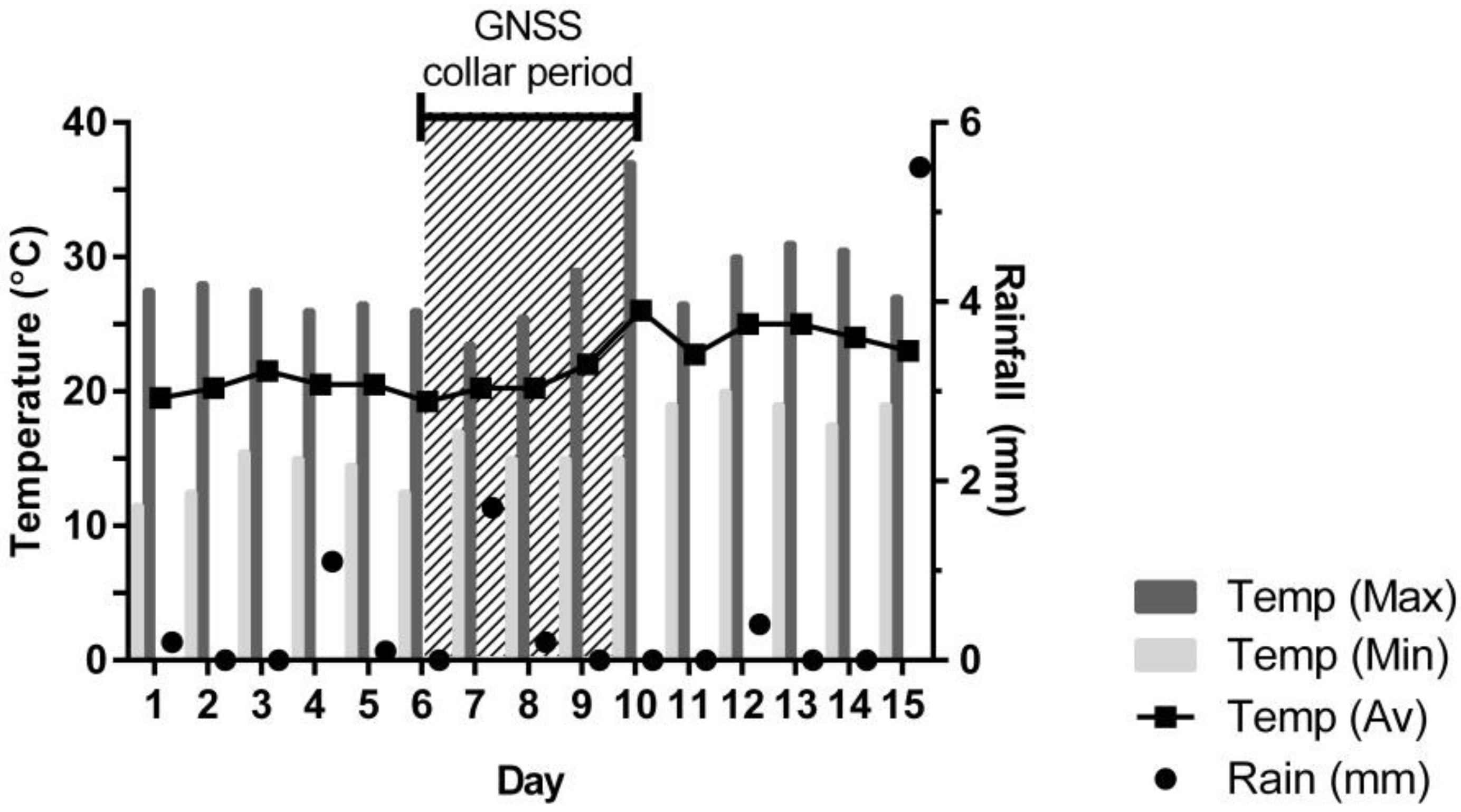
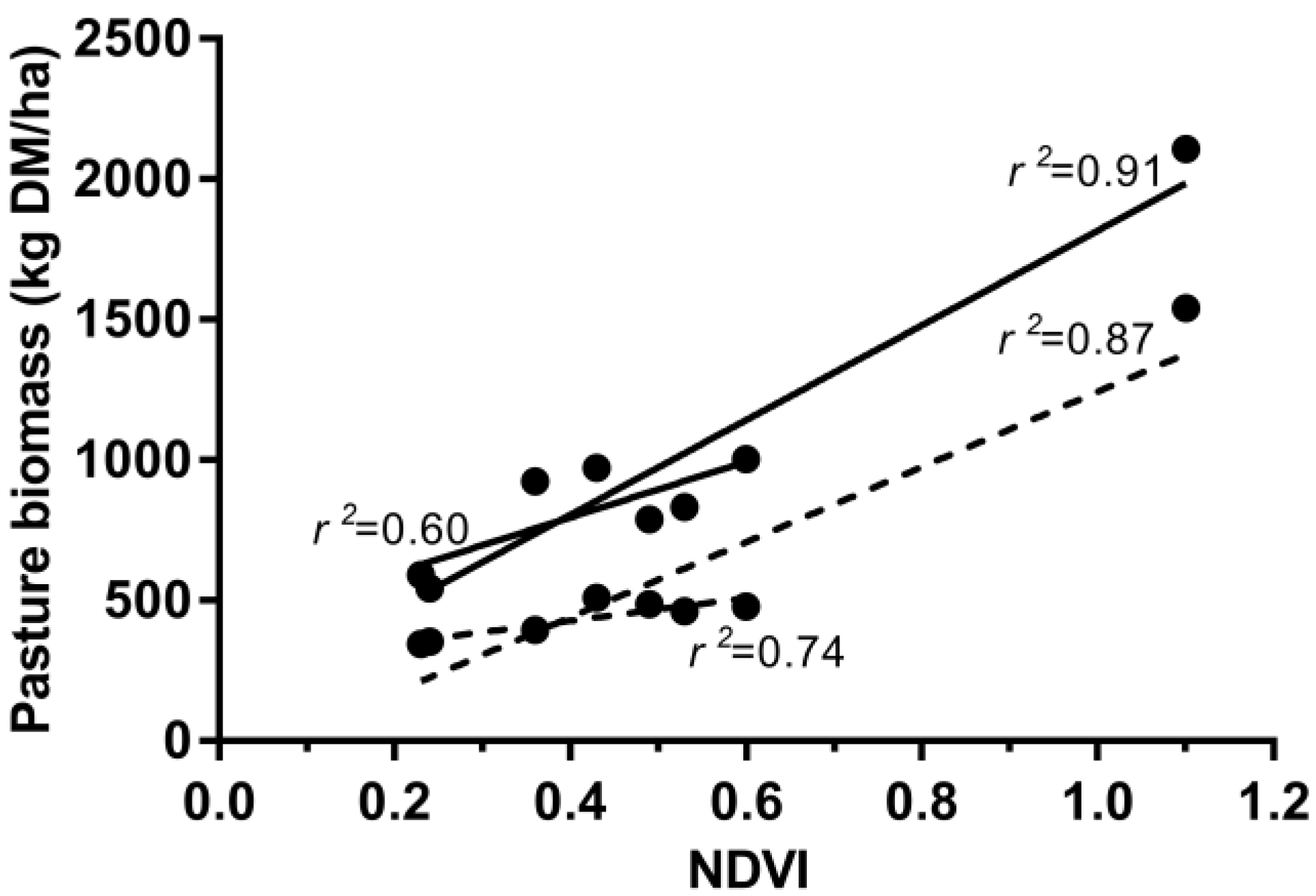
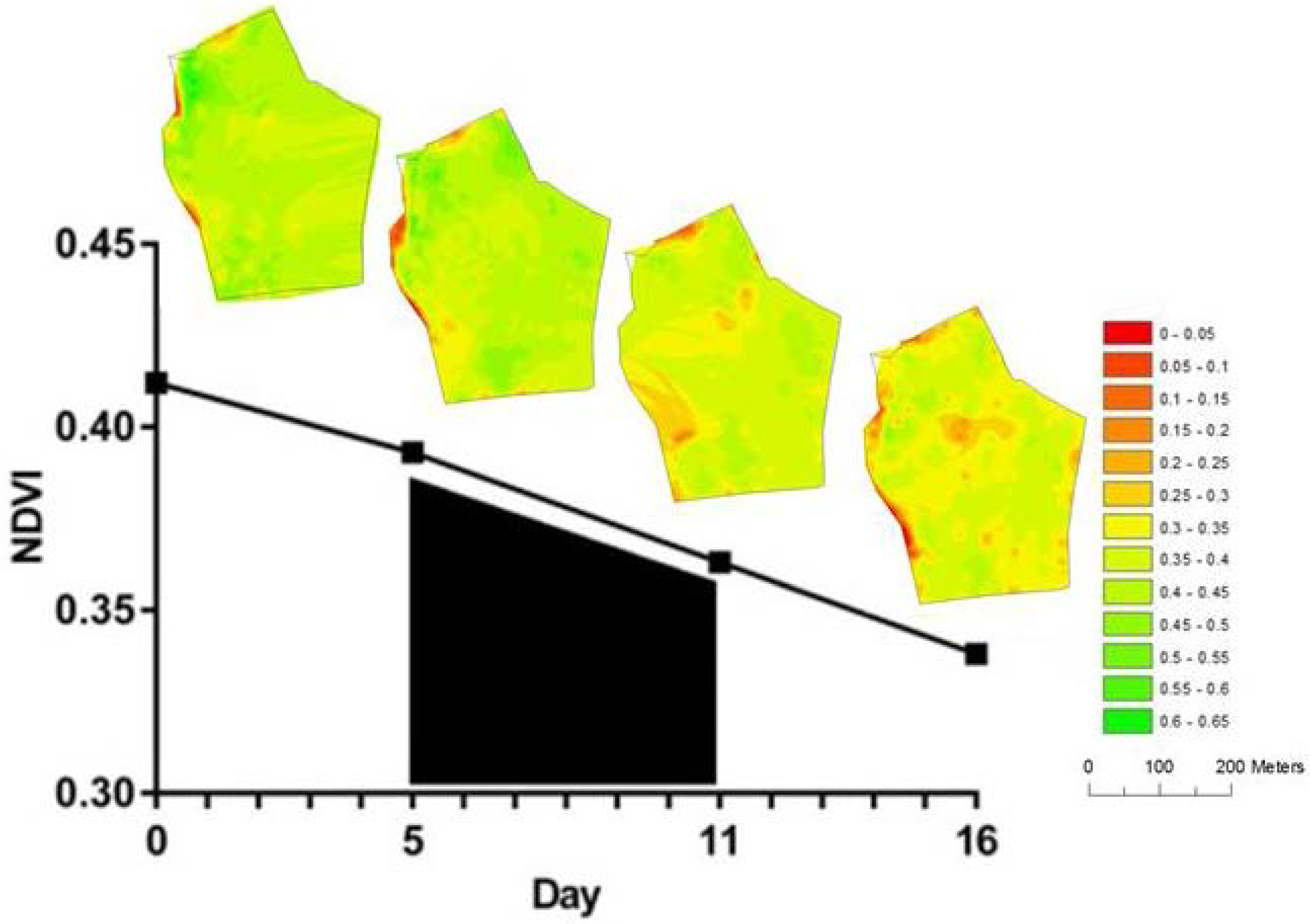

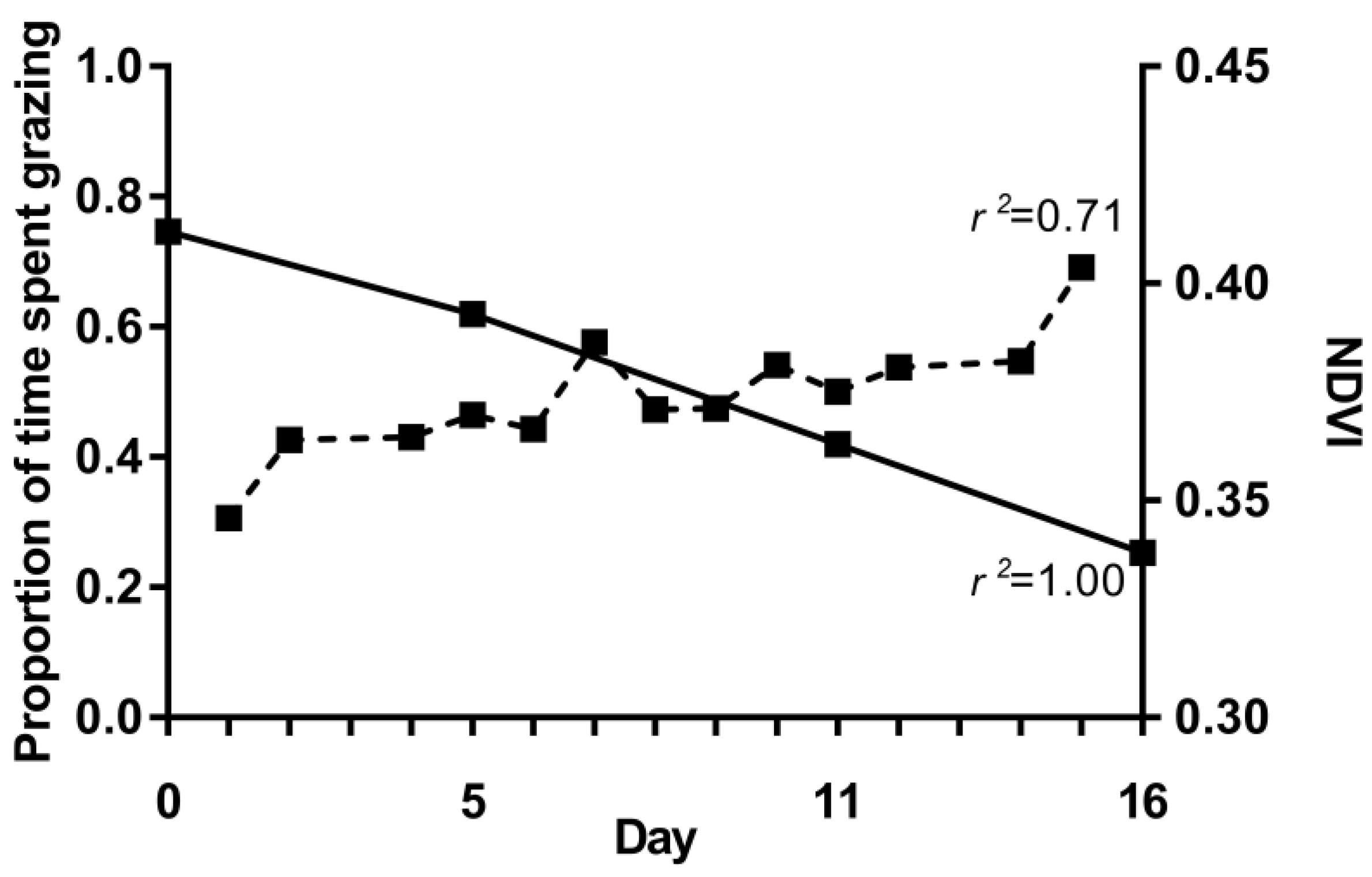
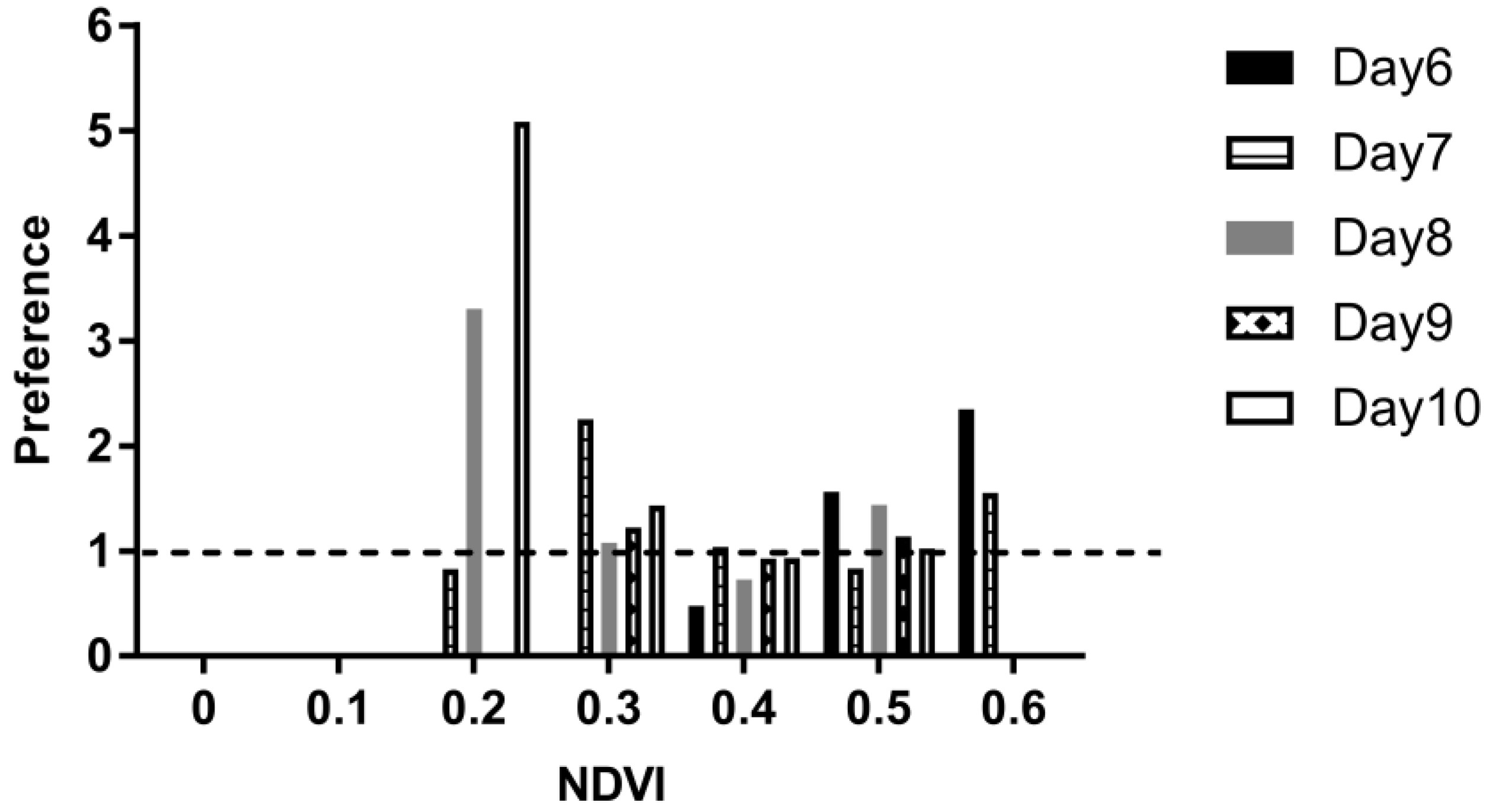
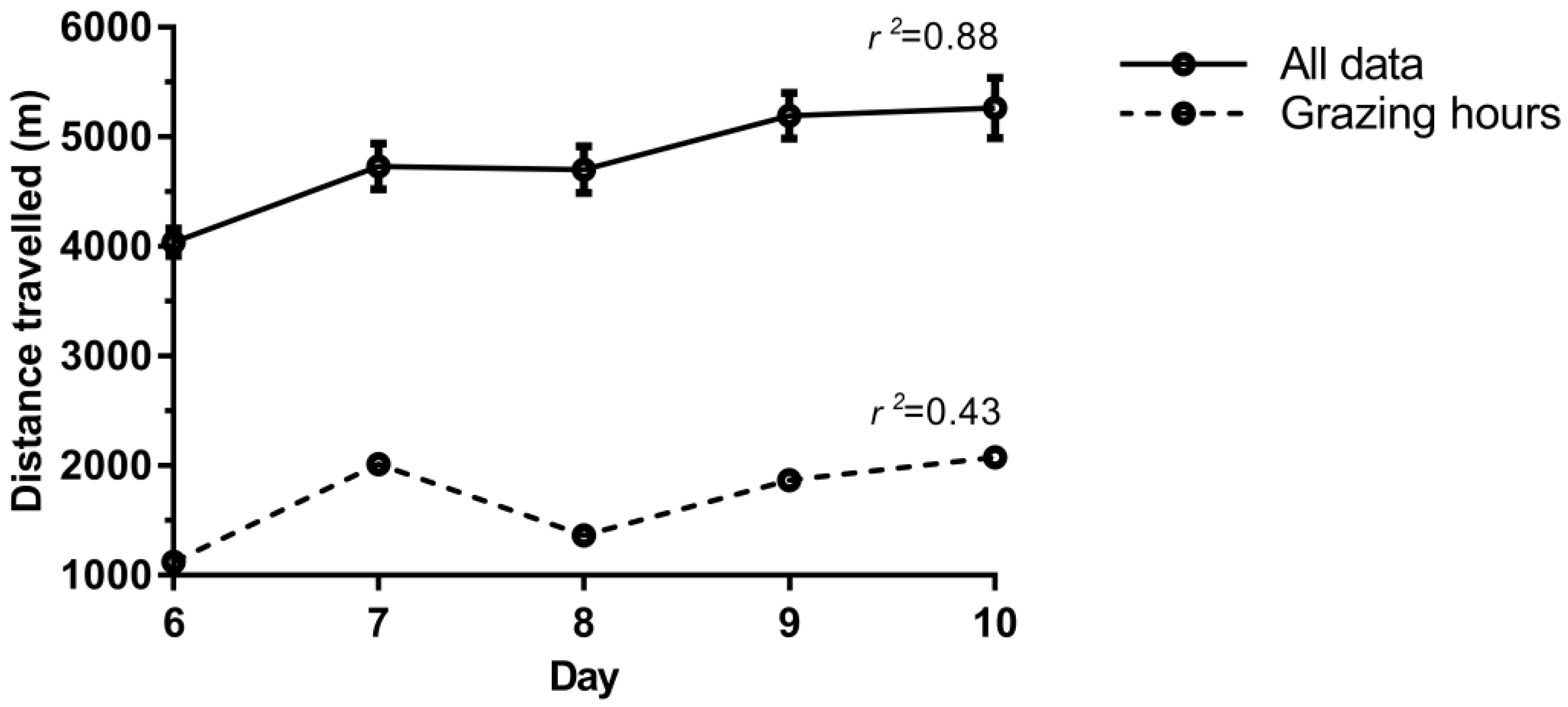
© 2017 by the authors. Licensee MDPI, Basel, Switzerland. This article is an open access article distributed under the terms and conditions of the Creative Commons Attribution (CC BY) license (http://creativecommons.org/licenses/by/4.0/).
Share and Cite
Manning, J.; Cronin, G.; González, L.; Hall, E.; Merchant, A.; Ingram, L. The Behavioural Responses of Beef Cattle (Bos taurus) to Declining Pasture Availability and the Use of GNSS Technology to Determine Grazing Preference. Agriculture 2017, 7, 45. https://doi.org/10.3390/agriculture7050045
Manning J, Cronin G, González L, Hall E, Merchant A, Ingram L. The Behavioural Responses of Beef Cattle (Bos taurus) to Declining Pasture Availability and the Use of GNSS Technology to Determine Grazing Preference. Agriculture. 2017; 7(5):45. https://doi.org/10.3390/agriculture7050045
Chicago/Turabian StyleManning, Jaime, Greg Cronin, Luciano González, Evelyn Hall, Andrew Merchant, and Lachlan Ingram. 2017. "The Behavioural Responses of Beef Cattle (Bos taurus) to Declining Pasture Availability and the Use of GNSS Technology to Determine Grazing Preference" Agriculture 7, no. 5: 45. https://doi.org/10.3390/agriculture7050045
APA StyleManning, J., Cronin, G., González, L., Hall, E., Merchant, A., & Ingram, L. (2017). The Behavioural Responses of Beef Cattle (Bos taurus) to Declining Pasture Availability and the Use of GNSS Technology to Determine Grazing Preference. Agriculture, 7(5), 45. https://doi.org/10.3390/agriculture7050045








